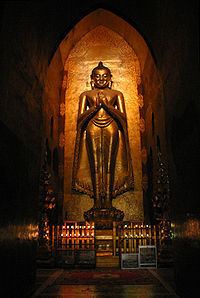Burmese ကောဏာဂုံ [kɔ́nàɡòʊɴ] Mongolian Канагамуни Vietnamese Phật Câu Na Hàm Mâu Ni | Chinese 拘那含牟尼 Tibetan Serthub Succeeded by Kassapa Buddha | |
 | ||
Japanese 拘那含牟尼; くなごんむに; Kunagonmuni | ||
Koṇāgamana Buddha (Pāli), known as Kanakamuni in Sanskrit, also known as Koṇāgon or Kanakagamana, is one of the ancient Buddhas whose biography is chronicled in chapter 23 of the Buddhavamsa, one of the books of the Pāli Canon.
According to Theravāda Buddhist tradition, Koṇāgamana is the twenty-sixth of the twenty-nine named Buddhas, the fifth of the Seven Buddhas of Antiquity, and the second of the five Buddhas of the present kalpa.
The present kalpa is called the bhadrakalpa (Auspicious aeon). The five Buddhas of the present kalpa are:
- Kakusandha (the first Buddha of the bhadrakalpa)
- Koṇāgamana (the second Buddha of the bhadrakalpa)
- Kassapa (the third Buddha of the bhadrakalpa)
- Gautama (the fourth and present Buddha of the bhadrakalpa)
- Maitreya (the fifth and future Buddha of the bhadrakalpa)
Koṇāgamana was born in Subhagavati Park in Sobhavati (now known as Araurakot, located about 3 kilometres (1.9 mi) southwest of Nigalihawa) on Wednesday; because of this Koṇāgamana is placed on the Wednesday pedestal.
According to Xuanzang, Koṇāgamana's relics were held in a stupa in Nigalisagar, in what is now Kapilvastu District in southern Nepal. There is an Ashoka pillar at the site today. Ashoka's inscription in Brahmi is on the fragment of the pillar still partly buried in the ground.
